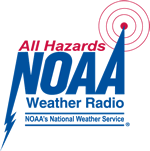NOAA All Hazards Weather Radio |
 |
NOAA Weather Radio is a free public service of the National Oceanic and Atmospheric Administration. The National Weather Service operates a network of NOAA Weather Radio stations across the country, and there are a handful of these stations in Arizona. Our staff prepares the broadcasts for the Phoenix, Yuma, and Globe radio stations, and the remaining stations in Arizona are handled by offices in Flagstaff and Tucson.
NOAA Weather Radio broadcasts are commercial-free, and operate 24 hours a day, 7 days a week. Routine broadcasts prepared by NWS Phoenix include current weather conditions, local and extended forecasts, Arizona weather summaries, travelers forecasts, and climate summaries.
During severe weather, routine weather programming will be interrupted with special statements and warning messages bringing you up-to-the-minute information on the developing weather situations. In addition, the specially equipped NOAA Weather Radio receivers can sound an alarm when extremely threatening weather is approaching your community.
The most important feature of NOAA Weather Radio is this capability to tone activate weather radio receivers. This feature can turn on weather radio receivers alerting the listener that severe weather is imminent. The primary mission of the NWS is to issue severe weather warnings to protect life and property. The NOAA Weather Radio ensures consistent "Alarm" service directly to the public, schools, hospitals, day care centers, and commercial broadcasters.
Specific Area Message Encoding (SAME) technology allows you to program specially equipped NOAA Weather Radio receivers to sound a warning alarm tone for only specific types of weather events in select geographic areas. For example, a resident of Phoenix could set their NOAA Weather Radio receiver to activate an alarm tone ONLY for tornado and flash flood warnings affecting Maricopa county. Another resident of Casa Grande may wish to set their receiver to receive ANY type of warning, but only those affecting Pinal county. Thus, the SAME system allows you to tailor your weather radio to alert you only to the types of watches or warnings you desire to hear, and only in the geographic area you've chosen.
To take advantage of SAME technology, you must have a specially designed NOAA Weather Radio receiver. For more information on SAME, including SAME codes for any county in the United States, please visit the National SAME page.
NOAA Weather Radio in Arizona and Southeast California
| Transmitter location (Click for Coverage Map) |
Frequency (Mhz) | Programming originates from |
|---|---|---|
| Flagstaff | 162.400 | NWS Flagstaff |
| Globe (Signal Peak) | 162.500 | NWS Phoenix |
| Grand Canyon (Hopi Point) | 162.475 | NWS Flagstaff |
| Greer | 162.525 | NWS Flagstaff |
| Nogales | 162.500 | NWS Tucson |
| Payson (Mt. Ord) | 162.425 | NWS Flagstaff |
| Phoenix | 162.550 | NWS Phoenix |
| Prescott | 162.525 | NWS Flagstaff |
| Tucson | 162.400 | NWS Tucson |
| Safford (Heliograph Pk) | 162.550 | NWS Tucson |
| Window Rock | 162.550 | NWS Flagstaff |
| Yuma | 162.550 | NWS Phoenix |
| Kingman | 162.425 | NWS Las Vegas |
| Lake Havasu City | 162.400 | NWS Las Vegas |
| Bullhead City, NV | 162.500 | NWS Las Vegas |
| Lake Powell (AZ/UT) | 162.550 | NWS Salt Lake City |
| Las Vegas, NV | 162.550 | NWS Las Vegas |
| Saint George, UT | 162.475 | NWS Salt Lake City |
| Coachella, CA | 162.400 | NWS San Diego |
| Coachella, CA (Spanish) | 162.525 | NWS San Diego |